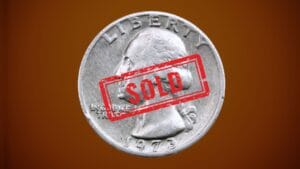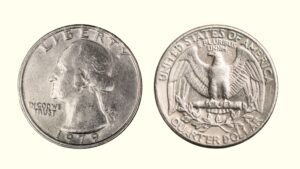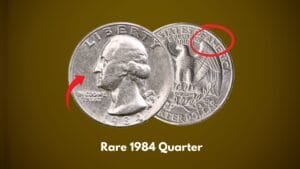An ordinary-looking clad coin, the 1978 Washington Quarter is a collectible coin you must not miss spotting in your collection! Why? Because this small coin can fetch up to two thousand dollars today (or even more)! If you want to know the real value of your coin, find all the crucial features that collectors look for, from mint marks to rare errors!

A Brief of 1978 Washington Quarter Dollar History
The Washington Quarter, first introduced in 1932 to commemorate the 200th anniversary of George Washington’s birth, continued its production run through 1978 with the same iconic design by sculptor John Flanagan.
The 1978 Washington quarter, while no longer containing silver (having switched to copper-nickel in 1965), maintained the same high production standards. During this year, the Mint operated a few facilities producing these quarters: Philadelphia, West Point, Denver, and San Francisco.
San Francisco exclusively focused on proof 1978 quarters. Today, these coins are worth a decent amount at auctions or sales, thanks to their historical significance.
| 1978 Washington Quarter | Key Facts |
| Coin Composition | copper-nickel-clad |
| Minting Location | Philadelphia, Denver, West Point, San Francisco |
| Year of Minting | 1978 |
| Weight | 5.67 g |
| Diameter | 24.26 mm |
| Thickness | 1.75 mm |
| Designer | John Flanagan |
| Face Value | $0.25 (25 cents) |
| Mint Marks | D – Denver Mint S – San Francisco No Mint Mark – Philadelphia |
| Total Mintage | 811,952,933 coins |
How to Identify a Real 1978 Quarter? (Design & Features)
The first step to assessing an old 1978 Washington quarter’s value is to verify its design details and physical features, like composition, size, and edges.
1978 Quarter Obverse:

- A left-facing profile of George Washington
- “IN GOD WE TRUST” written on the lower-left
- “LIBERTY” above Washington’s head
- The mint date “1978” at the bottom
- “D” or “S” mint mark, if present, near Washington’s ponytail
1978 Quarter Dollar Reverse:

- A left-facing eagle with spread-out wings and arrows in claws
- Two olive branches connected by a knot below the eagle
- “UNITED STATES OF AMERICA” along the upper half-edge
- “E. PLURIBUS UNUM,” in small fonts above the eagle’s head
- The denomination “QUARTER DOLLAR” on the bottom
1978 Quarter Coin Composition, Weight & Size
The 1978 Washington quarter is composed of a copper-nickel clad composition, specifically 91.67% copper and 8.33% nickel bonded to a pure copper core. This gives the coin its distinctive silver-like appearance while containing no precious metals.
This 25-cent coin has a 24.26 mm wide diameter and 1.95 mm thickness, with a clean, well-reeded edge. Make sure to verify all these details; if your coin’s features don’t match them, it could indicate it’s a counterfeit!
Finding a 1978 Washington Quarter Value (3 Key Factors)
The value of a 1978 Washington quarter varies significantly based on rare errors, proof strike, and the coin’s condition, professionally assessed on a scale of P-1 (Poor) to MS70 (Mint Gem State). Generally, higher-grade 1978 quarters of all varieties are worth more than circulated coins with visible wear and tear.
Let’s understand other factors in detail!
1. Mint Marks & Mintage
The 1978 Washington quarter saw substantial production across three U.S. Mint facilities, with a combined total mintage of 721,156,000 pieces. However, each mint location added a unique mint mark, impacting the coin’s rarity and value!
| Coin Grades | Condition Details | 1978 No Mint Mark Quarter Value | 1978 D Quarter Value |
| Poor (0) to Extremely Fine (XF45) | Significant wear, faded but visible details | 10 to 20 cents | 10 to 50 cents |
| Almost Uncirculated (AU50) to Mint State (AU58+) | Slight wear on highest points, visible marks or blemishes | 50 cents to 80 cents | 50 cents to $1 |
| Mint State (MS60 – MS64) | Uncirculated with minimal wear | $1 – $5 | $2 – $8 |
| Mint State (MS65 – MS66+) | Nearly flawless with very minor imperfections | $5 – $30 | $10 – $35+ |
| Mint State (MS67 – MS67+) | Well-preserved with no major flaws | $60 – $2,500+ | $150 – $1,500+ |
| Mint State (MS68 or Above) | Nearly perfect, luster, no major marks or flaws | N/A | N/A |
1978 No Mint Mark Quarter Value (Mintage – 521,452,000)
While many collectors think only the Philadelphia Mint struck over 521.4 million 1978 quarters, that’s not true! The 1978 Washington Quarters with no mint mark were produced at both Philadelphia and West Point Mints. However, since there’s no mark or feature to distinguish both versions, they’re valued equally.
In average conditions, a 1978 no mint mark quarter is worth the face value (or maybe less). Uncirculated MS-65 examples are typically valued at $10-$20. The highest-grade examples, like MS-67+, have reached impressive values of around $2,000, like the one sold for $2,875 on eBay in 2021.
1978 D Quarter Value (Mintage – 287,373,152)
The Denver Mint produced over 287.3 million Washington Quarters in 1978, all featuring a unique “D” mint mark. Due to their lower mintage, these coins can be slightly more valuable in high grades.
While second in production volume, Denver strikes often display slightly better average quality than their Philadelphia counterparts. Uncirculated MS-65 Denver quarters generally command $12-$25, with superb MS-67+ examples fetching higher prices of up to $1,500!
MS68 examples of a 1978 Washington Quarter are rare to find and could fetch even higher amounts if sold!
2. 1978 S Washington Quarter Proof Strike
The San Francisco Mint didn’t make any business coins in 1942. It only produced 3,127,781 proof quarter dollars, featuring a sharp S mint mark and the unique reflective proof finish with frosted devices (raised designs, like Washington’s profile and eagle).
Generally, proof coins are more valuable than regular strikes, but that’s not the case with 1978 quarter proof coins. They are generally worth $5 to $60 depending on grades ranging from PR60 to PR70.
The most expensive PR70 1978 S quarter proof coin sold for $472 on Heritage Auctions, and that was almost two decades ago.
3. Rare 1978 Washington Quarter Errors
The last factor to significantly influence an old 1978 quarter dollar value is minting errors (flaws that happen during the minting/striking process). Here are the most notable 1978 quarter errors to look for:
Double Struck with 2nd Strike 65% Off Center
This dramatic error shows two distinct impressions (doublestruck error) of the design, with the second strike dramatically misaligned and partially missing the planchet. This eye-catching error coin can sell for $200-400 in uncirculated grades, like this MS63 example bought for over $290 on Heritage Auctions!
Off-center Strike
This error occurs when the planchet is misaligned between the dies during the striking process, resulting in part of the design missing! For 1978 quarters, off-center errors can fetch $50-100 in uncirculated state. For example, an MS63 example with 30% off-center sold for $57, and MS60 specimens with 10% off-center sold for $74 in a coin auction!
Struck on an Improperly Annealed Planchet (PL)
This error occurs when the metal planchet is not properly softened and annealed before striking, resulting in an uneven, mottled finish. These poorly annealed quarters have a unique, often matte or pebbly appearance.
An MS66-grade 1978 quarter with this error sold for almost $100, which is an exceptional price for this grade.
Struck on a 5C Planchet
This extremely rare error happens when a 1978 Washington quarter is accidentally struck on a 5-cent (nickel) planchet. These quarters are noticeably smaller and lighter than normal with a weight of 5.0g instead of 5.67g. Hard to find, these rare coins can fetch stunning prices in mint state, like this MS65 example struck on a 5C planchet sold for $470!
In addition to these coins, look for the common double die errors, re-punched mint marks, and die break cud errors. Make sure to identify all these rare features before you buy or sell an old 1978 Washington quarter dollar!








